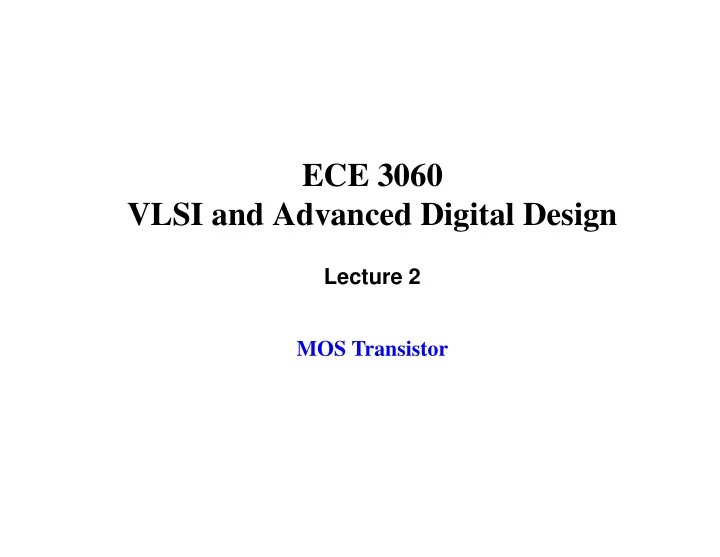

ECE 3060 VLSI and Advanced Digital Design Lecture 2 MOS Transistor
The pn Junction • Majority carriers diffuse from n to p and from p to n, leaving trapped impurity (donor) ions behind • Width of depletion region is inversely proportional to carrier concentration >5V ECE 3060 Lecture 2–2
MOS Subthreshold Region ≈ ≤ • Subthreshold Region , I ds 0 V gs V • Subthreshold current is due to reverse bias leakage current of diode between diffusion and substrate ECE 3060 Lecture 2–3
MOS Linear Region • The inversion layer (channel) is symmetric, until: 2 V ds β ( ) V ds ≤ ≤ • I ds V gs V t O V ds V gs V t = – – - - - - - - - - - – 2 ECE 3060 Lecture 2–4
MOS Linear Region • Transverse electric field distorts the channel 2 V ds β ( ) V ds ≤ ≤ • I ds V gs V t O V ds V gs V t = – – - - - - - - - - - – 2 ECE 3060 Lecture 2–5
MOS Saturation Region ≤ • Channel is pinched off when V gs – V t V ds • Current is swept through depletion region electric field after leaving channel. ECE 3060 Lecture 2–6
Channel Length Modulation • When the device is in saturation the effective channel length is decreased • Therefore the transconductance is increased λ • is an empirical channel length modulation factor kW ) 2 1 ( ( λ V ds ) • - - - - - - - - V gs I ds = – V t + 2 L ECE 3060 Lecture 2–7
MOSFET Curves ECE 3060 Lecture 2–8
Drain Punchthrough • If drain voltage is sufficiently high, depletion region may extend all the way to the source • Then carriers are diffused from source into depletion region, and swept through E field to drain. ECE 3060 Lecture 2–9
Hot Carriers • As we scale down gate length L, and if Vdd is fixed, the channel E field is increased. • Since mean free path is fixed, charge carriers achieve higher velocity • Hot electrons can ionize drain holes, which are repelled from the drain to the substrate • Substrate current • Latchup • Damage • Lower Vdd ECE 3060 Lecture 2–10
Body Effect • When the source to substrate bias is positive, the channel substrate depletion region increases. • This reduces the channel (charge neutrality), and hence increases the threshold voltage. • Body effect may adversely impact the onset of switch- ing, and hence gate delay, in complex gates with long chains of FETS. ECE 3060 Lecture 2–11
Transistor Sizing µ ε • Process transconductance: - - - - - - - k = t ox kW β • Device transconductance: - - - - - = L µ n ≈ 2 µ p • Carrier mobility depends on type ECE 3060 Lecture 2–12
Structure of an IC • IC is built on Si substrate with a number of processes • Wires are fabricated from metal (Al or Cu) or polysili- con • Insulation is silicon dioxide (SiO 2 ) • Wires and contacts/vias are patterned by etching • Transistor source/drain regions and wells are doped by diffusion • Threshhold voltages are adjusted by doping channel by implant ECE 3060 Lecture 3–3
Photoresist • An IC layer may be selectively etched or doped by applying, exposing and developing a photoresitive polymer layer. • The polymer is hardened by exposure to actinic (high E) photons • The unexposed photo resist is washed away leaving an etchant resistive mask Photons Mask Photoresist Metal SiO 2 ECE 3060 Lecture 3–4
Etching • A metal layer may be etched to form wires • An SiO 2 layer may be etched to form contacts/vias • The polymer may be used to control doping • Finally the polymer is removed Etch Photoresist Metal SiO 2 ECE 3060 Lecture 3–5
Silicon Dioxide • SiO 2 comes in three flavors • field or thick oxide is grown between transistors • thinox is a very thin layer used underneath the gate • SiO 2 is also deposited between layers as an insulator ECE 3060 Lecture 3–6
Contact Fabrication patterned photo-resist interlayer insulator layer 1 etch layer 2 interlayer insulator layer 1 ECE 3060 Lecture 3–11
Recommend
More recommend